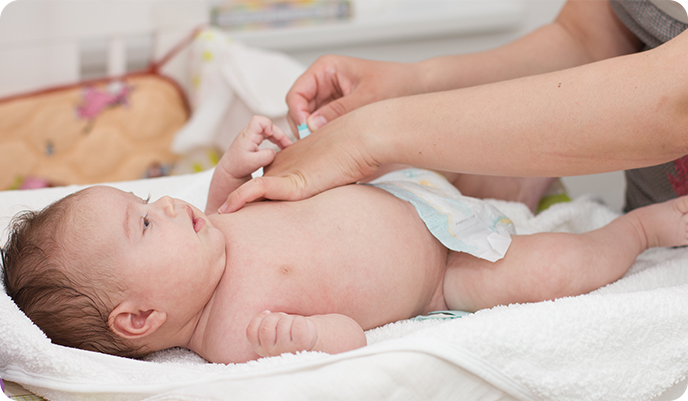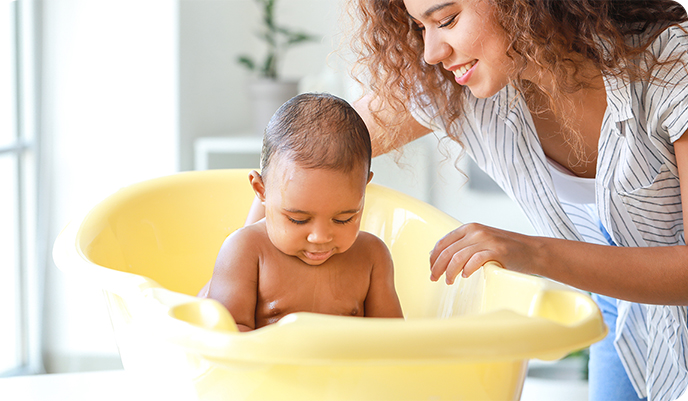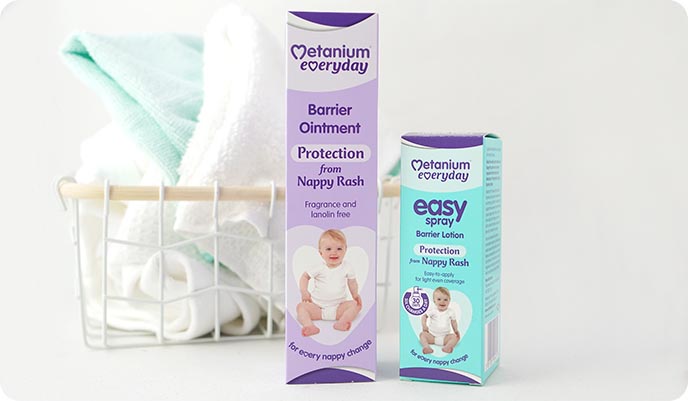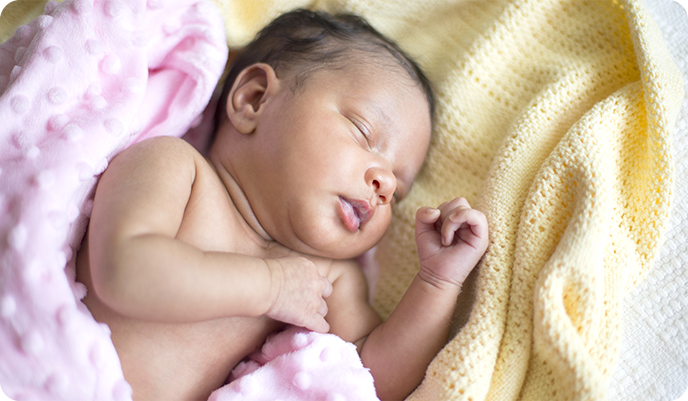Here at Metanium we have been treating and protecting babies’ bums for over 30 years and we love sharing our tried and tested tips to help our Metanium community.
Nappy rash is common in all babies and typically happens when the delicate skin around your baby’s nappy area becomes irritated. Most babies with mild nappy rash don’t feel sore at all, but more severe cases can cause your baby’s bum to feel sore.
Usually nappy rash will clear up on its own within three to four days, however for those with little ones suffering from regular outbreaks, we understand it can be hard seeing your baby in discomfort. Read on to find out when nappy rash is most likely to strike, along with our top tips for preventing and treating it.

5 TIPS TO HELP TREAT NAPPY RASH
1. Change wet or dirty nappies frequently
Nappy rash usually starts when your baby’s skin is in contact with wee or poo for a long time, as this can lead to irritation and chafing. We understand that life as a parent can get super busy, and sometimes it can be difficult to keep on top of the constant nappy changes - however, changing your little one’s nappy as regularly as possible will help to protect their skin.
If you’re currently expecting and are unsure what to expect, newborn baby’s nappies will need changing around 10 or 12 times a day and as they get older, their nappies will need to be changed at least 6 to 8 times a day.
2. Clean the whole nappy area
Keep your baby’s bum as clean as possible by making sure you clean the whole nappy area gently but thoroughly, wiping from front to back. Using warm water and cotton wool will be kind on your baby’s skin, but if you opt to use baby wipes for convenience, we recommend fragrance-free and alcohol-free wipes.
We would also recommend avoiding harsh products that may irritate their skin, such as fragranced bubble bath, detergent, and talcum powder.
3. Bath them daily
Bath time is a great opportunity to spend some one-on-one quality time with your baby! Talking to them as you wash them, counting their tiny toes and even getting some toys to play with together, will help to make bathtime a fun and special experience for both of you! Bathing your baby every day will help remove irritants and possible bacteria which may have built up during the day. Make sure to dry your baby gently after washing them to prevent any further chafing!
Avoid bathing them more than twice a day as this could dry out their skin and make the area sore.

4. Let them be free
After your baby has been bathed or changed, lie them on a towel and leave their nappy off for as long as you can to let fresh air get to their skin. Your baby will love this nappy-free time and will enjoy being able to kick their legs in the air unrestricted by a nappy!
5. Use Metanium’s Nappy Rash Ointment (our treatment product)
After removing your baby’s used nappy, clean and wash the affected area, dry with a soft towel and dab a small amount of our Metanium Nappy Rash Ointment Treatment onto the affected areas. Our iconic yellow one has been specifically formulated to soothe and treat your baby’s delicate skin - and is vegan friendly too!
All you need is a pea-sized amount of the ointment, so make sure to squeeze the tube very gently; this will help you to keep it in good condition as well as saving product. To make your Metanium product last longer, you should also wipe around the neck of the tube after each use, clean away the residual product and close the cap tightly.
When you put their nappy on, make sure it isn’t too tight and leave some breathing room. You can find out where to buy Metanium Nappy Rash Ointment on our stockists page or purchase directly on Amazon.
If your baby's nappy rash is spreading or getting worse, contact your GP or healthcare visitor.

HOW TO PREVENT NAPPY RASH
As parents, it can be easy not to think about nappy rash until your baby is actually experiencing symptoms - as a newborn parent especially, we understand you have enough on your plate!
However, adding a small prevention step into your baby’s daily skincare routine can help to protect their skin from nappy rash and prevent any disruption to your family. Nappy rash can be really painful for your baby and may disturb their sleeping or eating patterns.
So whether you’ve just gone through a nappy rash ordeal, or you’re currently expecting and wanting to prevent nappy rash in the future, here are two products that can help you:
Metanium’s Everyday Barrier Ointment
- A light barrier ointment which helps to protects your baby’s skin to help prevent nappy rash
- Our formula is unscented and does not contain lanolin
- 100% vegan-friendly
- 94% of parents recommend our Everyday Barrier Ointment*
*Home Tester Club survey September 2019. 397 respondents.
Metanium’s Everyday Easy Spray Lotion
- A quick & simple-to-use spray, the perfect product for changing on the go!
- All you need to do is shake well, spray at a distance and pat around the area for maximum coverage.
- Cares for delicate skin by forming a barrier to help protect against external irritants and prevent nappy rash
- Unscented and does not contain lanolin
- Should last 30 days based on 6 changes a day
- 100% vegan-friendly

THE 7 TRIGGER TIMES FOR NAPPY RASH
There are a few key moments during your baby’s first years where they are more prone to nappy rash:
- Weaning
Introducing solid foods can lead to loose stools or diarrhoea and it can be difficult to keep your baby’s bottom clean during this time. - Diet
In addition to weaning, any change in diet or milk can cause runny poo* leading to a greater likelihood of nappy rash. - Common Cold
Along with a runny nose, babies are more likely to have loose stools or diarrhoea which increases the frequency of nappy changes. - Teething
Teething can often bring on diarrhoea, meaning a higher chance of nappy rash for your baby. - Sleeping longer
Although an exciting time for parents, once your baby starts to sleep for longer they may develop nappy rash as they will be spending longer periods of time in the same nappy. - Antibiotics
Antibiotics may mildly upset the digestive system which will lead to diarrhoea, making nappy rash more likely. - An upset stomach
If your baby has diarrhoea and is frequently passing watery poos, it’s much more difficult to prevent nappy rash.
* Morris H, The bottom line on nappy rash, British Journal of Midwifery, September 2012, Vol 20, No 9, pages 540-543.
We hope this article helped you to learn more about the ways to treat and prevent nappy rash. Do you have any other questions about nappy rash? What tips would you like to hear from us? Let us know on Instagram or Facebook.
Related posts
Metanium Nappy Rash Ointment is a medicine. Always read the label.




